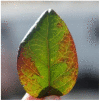Known and New Emerging Viruses Infecting Blueberry
- PMID: 34685980
- PMCID: PMC8539497
- DOI: 10.3390/plants10102172
Known and New Emerging Viruses Infecting Blueberry
Abstract
Blueberry (Vaccinium spp.) plants are exposed to existing and emerging viruses as a result of expanding acreage of blueberry plantations across the world, primarily in North America. Since blueberry is cultivated in areas where there are wild Vaccinium spp., there is increasing risk of virus movement between wild and cultivated blueberries. This is theoretically possible because viruses can spread from commercial cultivars to native species and vice versa causing the spread of existing and new viruses. The occurrence of these viruses in blueberry can be devastating to the industry considering the cost for cultivation and production of this perennial crop. However, the advent of high-throughput sequencing and bioinformatic sequence analysis have allowed for rapid identification of known and novel viruses in any crop including blueberry, thus facilitating proper intervention in response to serious viral diseases. In this paper, we aim to focus on the current status of known and novel viruses emerging in blueberry worldwide, which may impact the blueberry industry.
Keywords: Vaccinium; blueberry; viruses.
Conflict of interest statement
The authors declare no conflict of interest.
Figures



References
-
- Luby J.J., Ballington J.R., Draper A.D., Pliszka K., Austin M.E. Blueberries and cranberries (Vaccinium) Genet. Resour. Temp. Fruit Nut Crop. 1991;290:393–458. doi: 10.17660/ActaHortic.1991.290.9. - DOI
-
- FAOSTAT . Food and Agriculture Organization of the United Nations. FAO; Rome, Italy: 2019. [(accessed on 19 August 2021)]. Production: Crop. Blueberry. Available online: https://www.fao.org/faostat/en/#data/QCL.
-
- USDA/ERS . Fruit and Tree Nuts Outlook: September 2020. ERS, USDA; Washington, DC, USA: 2020.
-
- Hancock J., Lyrene P., Finn C., Vorsa N., Lobos G. Temperate Fruit Crop Breeding. Springer; Berlin/Heidelberg, Germany: 2008. Blueberries and Cranberries; pp. 115–150.
-
- Ballington J. The role of interspecific hybridization in blueberry improvement. Acta Hortic. 2009;810:49–60. doi: 10.17660/ActaHortic.2009.810.2. - DOI
Publication types
LinkOut - more resources
Full Text Sources
Other Literature Sources
Miscellaneous

